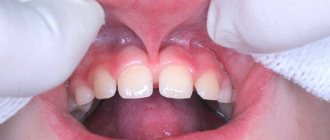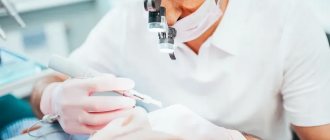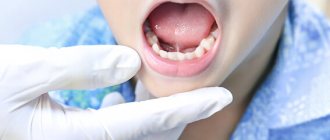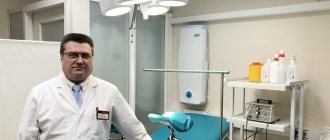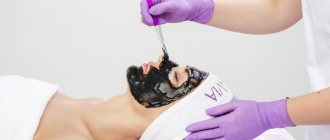The labial frenulum is a fold of mucous membrane (between the central incisors of the upper and lower teeth) that connects the lip and gum. It is involved in lip movement and articulation in speech. The health of the teeth, the correctness of the bite, the pronunciation of sounds, and the beauty of the smile depend on the quality and elasticity of the place where it is fixed to the gum.
The frenulum of the lip meets the gingival tissue at a distance of 5-8 mm from the necks of the anterior teeth. If it starts very close to the teeth, then it is considered to be shortened. It may also be that the frenulum is too wide. To avoid unpleasant consequences in the future or eliminate existing problems, doctors often recommend plastic surgery of the labial frenulum.
What is dangerous about the pathology of the frenulum attachment?
Indications for frenuloplasty arise not because of doctors’ desire to correct an anatomical feature, but for compelling reasons that affect the health and beauty of the smile. A similar defect results in:
- to the formation of a diastema - an excess gap (gap) between the front incisors, which, moreover, tends to expand. A short frenulum is fixed too close to the edge of the alveolar process and pushes the teeth in different directions;
- the appearance of a gum pocket - a depression behind the gum due to its injury by the frenulum, where food debris begins to accumulate, tartar forms, and the exposed necks of the teeth suffer from increased sensitivity. Ultimately, this process can lead to periodontitis, loosening and loss of teeth;
- speech problems - with a short frenulum it is difficult to pronounce many consonants and some vowels (“o”, “u”);
- bite pathologies - due to improper closure, tooth enamel is erased, teeth grow in the wrong direction, oral hygiene, the quality of chewing food and the functioning of the entire gastrointestinal tract deteriorate, and at the same time, a short frenulum prevents the correct installation of the braces system;
- difficulties when performing prosthetics - a short frenulum does not allow the prosthesis to be firmly held in the mouth, and it may fall out while eating or talking;
- injury during individual oral hygiene and its deterioration in general.
Upper lip frenuloplasty
Plastic surgery of the frenulum of the upper lip is a surgical intervention to trim the frenulum, performed on the patient if there are appropriate indications in the direction of an orthodontist or speech therapist. The frenulum of the lip is a special fold of the oral mucosa, which is responsible for additional attachment of the upper lip to the jaw bones.
In its normal position, the frenulum is woven into the gum at approximately a distance of 0.5-0.8 cm from the necks of the anterior incisors. With a lower attachment or when the frenulum of the lip extends beyond the front incisors and the attachment point is not visible at all, it is considered short. In such cases, it begins in the middle part of the upper lip and is attached approximately 0.4-0.6 cm above the gum, in the area of the gap between the front incisors (diastema).
A short frenulum is easily detected by visual inspection. To do this, you just need to retract the upper lip and examine the place where the mucous cord is woven.
When the frenulum is in a normal position, it does not have a negative effect on health and does not interfere with speech. A shortened frenulum can cause the development of a number of disorders. To correct it, an operation to plasticize the frenulum of the upper lip is performed.
Need for surgery
Most parents have a rather vague idea of the functions of the frenulum of the upper lip and its role in the normal functioning of the dental system. Therefore, when a specialist talks about the need for plastic surgery, many do not understand the importance of it. In reality, the problem must be resolved in a timely manner to avoid unpleasant medical and aesthetic consequences. It is the presence of the frenulum that allows you to correctly articulate, move your lips, open and close your mouth. With its defects (too short frenulum, its improper fastening), the mobility of the lips is significantly reduced, their functioning is disrupted, and various aesthetic defects develop.
The presence of such an anomaly leads to a number of consequences:
- Limited sucking function in newborns. Since in infants the upper lip, together with the tongue, takes an active part in sucking, impaired mobility becomes an obstacle to the process of breastfeeding. In some cases, a neonatologist can independently trim the frenulum of the upper lip.
- Impaired speech formation and correct sound pronunciation. With a shortened frenulum of the upper lip, as a rule, difficulties arise when pronouncing labial sounds, vowels (“o”, “u”, etc.). In this case, the speech therapist recommends plastic surgery, after which the diction is automatically corrected.
- At an older age, due to frenulum defects, bite and chewing functions may be impaired, resulting in digestive problems.
- The shortened frenulum of the lip, as well as its close attachment to the edge of the alveolar process, causes retraction of the interdental papillae of the gums in the space between the incisors. As a result, a gap is formed in the bone tissue between the sockets of the teeth - a diastema. In addition, the distance between the crowns increases.
- A short frenulum pulls back the gums and leads to the formation of a gum pocket, the deposition of tartar and the development of an inflammatory process in the gums.
- The consequences of defects in the frenulum of the upper lip can be instability of the teeth, exposure of their roots, and increased sensitivity. Plastic surgery allows you to avoid the development of a number of dental diseases.
- A frenulum that is too wide leads to regular accumulation of food debris and the formation of plaque.
- Surgery to correct the frenulum of the upper lip is necessary for the prevention of periodontal diseases and inflammatory processes in the oral cavity.
Indications
Medical intervention of any type must certainly be justified. A simple statement of the fact of the presence of a shortened frenulum is not an indication for emergency surgery. Plastic surgery to correct the frenulum is performed in the following cases:
- If there is a diastema (gap) between the central incisors. The frenulum of the upper lip, woven into the interdental papilla and forming a thick cord, prevents the incisors from converging towards the center. In addition, exposure to a small constant load leads to a gradual increase in the diastema and displacement of the teeth forward and to the sides from the center, as well as the development of periodontitis due to constant injury to the interdental papilla.
- In preparation for orthodontic therapy. Soft tissue cords located in the oral cavity, including the frenulum of the upper lip, exert a certain load on the dentition and influence the formation of the bite. If bite correction procedures are prescribed (installation of plates or braces), you also need to pay attention to the correct attachment of the upper lip frenulum.
- If you have periodontal diseases and are at increased risk of their occurrence. In these cases, the short frenulum seems to “pull” the mucous membrane from the base of the teeth, which leads to gum recession - raising its edge and exposing the roots of the teeth.
- In preparation for removable prosthetics. If the installation of dentures is planned, then it is first necessary to perform plastic surgery of the frenulum of the upper lip, since a shortened frenulum will provoke the shedding of the dentures.
- In case of impaired sound production and other speech therapy problems (as a rule, this indication is less common than others).
Optimal time for the procedure
Although plastic surgery of the upper lip frenulum is a minor operation and does not lead to any consequences, it is performed extremely rarely on infants - only when there is a significant disruption of the breastfeeding process
The optimal age is over 5 years. This is a period of active change of bite, loss of milk teeth and eruption of permanent teeth, when the central teeth have erupted by at least 1/3, and the lateral ones have not yet appeared. Carrying out plastic surgery at this stage will help avoid the formation of a gap and will help the central incisors move towards the center (the erupting lateral incisors will also help with this).
Some experts recommend correction of the upper lip frenulum at 7-8 years of age, when the four upper incisors have already fully erupted. If indicated, the operation is also performed in adolescence and older age.
Contraindications
Surgery to correct the frenulum is not performed in the presence of the following conditions and diseases:
- recurrent diseases of the oral mucosa;
- Smile before and after frenuloplasty
- osteomyelitis;
- multiple caries with complications;
- radiation irradiation of the head and neck area.
Of the general contraindications, it should be noted:
- cerebral lesions;
- dysmorphophobia;
- alcohol abuse;
- mental illness;
- blood diseases (leukemia, hemophilia);
- infectious diseases in the acute stage;
- chronic diseases;
- oncological diseases;
- collagenosis, tendency to form keloid scars.
Preparing for surgery
No special preparation is required for the procedure. The oral cavity should be sanitized, since the presence of a source of infection can lead to the development of complications. Some specialists prescribe tests and fluorography, but there is no particular need for them: plastic surgery of the frenulum of the upper lip is a low-traumatic operation.
The only recommendation is to pre-feed the child, since in a hungry state it is more difficult for him to tolerate the procedure. In addition, hunger can affect blood clotting.
Types of operations and their essence
One of the main conditions for a successful operation: the baby must sit in a chair in a calm state for at least 15 minutes. Plastic surgery is performed using various methods. The choice of a specific method depends on the structure and attachment of the frenulum of the upper lip.
- Frenotomy, or dissection of the frenulum. Its implementation is indicated in cases where the frenulum of the upper lip is too narrow, has the appearance of a transparent film and does not have points of attachment to the edge of the alveolar process. The dissection is carried out in the transverse direction, and suturing is carried out in the longitudinal direction.
- Frenectomy, or excision of the frenulum. Prescribed for wide frenulum of the upper lip. The incision is made along the crest of the tense frenulum, and the interdental papilla and tissues located in the bone space between the root parts of the spread central incisors are excised.
- Frenuloplasty – its essence is to move the attachment site of the frenulum of the upper lip. Currently, two types of frenuloplasty are performed.
Y-shaped frenuloplasty
After local anesthesia, the fixed frenulum is excised with a scalpel or special gum scissors. As a result of excision, a diamond-shaped defect remains on the mucosa. In order to mobilize the edge of the mucosa adjacent to the incision, it is trimmed and, using a thin rasp, moved along the periosteum in the apical direction (deep into the formed vestibule). Inside the vestibule, the mobilized mucous membrane is fixed with an interrupted suture to the periosteum. The wound is sutured tightly.
Z-shaped frenuloplasty (according to Limberg)
Infiltration anesthesia is performed, after which a vertical incision is made in the middle of the frenulum. Two oblique cuts are made in opposite directions from it at an angle of 60 to 85 degrees. The formed triangular flaps are mobilized and then fixed so that the central incision is located horizontally. It is very important to properly prepare the receiving bed: if the edges of the incisions are simply sutured together within the mucosa, you can only achieve a weakening of the tension, but it will not be possible to completely eliminate it. Ignoring this point leads to a significant decrease in the effectiveness of the procedure and, as a consequence, the not very popular popularity of this technique. The receiving bed is prepared in the same way as for Y-shaped frenuloplasty of the frenulum of the upper lip. The submucosal tissues are peeled off along the periosteum using a rasp, after which interrupted catgut sutures are applied to close the horizontal incision, while the flaps are fixed to the periosteum.
All of the above operations for plastic surgery of the upper lip frenulum are performed on an outpatient basis, under local infiltration anesthesia. For pain relief, Ultracan D-S forte containing epinephrine (1:100000 in 1.7 ml) is used.
Absorbable suture material is used to close the wounds, so they do not need to be removed later. The entire procedure takes approximately 15 minutes. According to reviews, it is completely painless and does not even cause discomfort.
Laser plastic surgery
Lately, plastic surgery of the upper lip frenulum using a laser has become very popular. The whole procedure takes only a few minutes.
Local anesthesia is first performed using a special gel, after which the light guide of a laser device is directed to the frenulum, forming a focused beam of light. Under its action, the frenulum “dissolves”. The laser also sterilizes and seals the edges of wounds.
Advantages of the method:
- absence of vibrations and unnecessary sounds that frighten children;
- bloodlessness;
- no need for stitches;
- eliminating the possibility of infection from surgical instruments by sealing the edges of wounds with a laser;
- reducing the time of surgery for plastic surgery of the upper lip frenulum;
- absence of pain and postoperative scars;
- short rehabilitation period.
Postoperative care
As a rule, the period after plastic surgery of the upper lip frenulum is quite calm. Minor pain may occur after the anesthetic wears off. Rules to follow at this time:
- Perform thorough oral hygiene daily.
- Avoid hot and solid foods for 2 days.
- Go through a post-operative examination (on the second or third day).
For older patients, special myogymnastics is recommended - exercises to strengthen facial and chewing muscles.
Over a certain period of time after frenuloplasty, one becomes accustomed to the freer movements of the tongue. Diction changes almost immediately after the correction. To eliminate the gap between the teeth (if it has already formed) it takes a little longer, and in some cases additional dental treatment is necessary.
The rehabilitation period lasts no more than 4-5 days. During this time, all unpleasant sensations disappear, and the wounds are completely healed.
Are there any contraindications?
When deciding whether to undergo lip frenuloplasty, the doctor will definitely assess the risks and check for contraindications. There are few of them, since the operation is considered minimally invasive:
- recurrent pathologies of the oral mucosa;
- tendency to develop keloid scars;
- bleeding disorders;
- inflammatory diseases of the jaws;
- decompensated forms of chronic systemic diseases;
- general disorders - mental disorders, cerebral pathologies, oncological processes, exacerbations of chronic diseases.
What pathologies require solutions?
Normally, the frenulum of the tongue starts from the tip of the organ and ends in the area of the lower incisors. It is located exactly in the center (bottom). These are the perfect sizes. The main pathology that occurs is a shortened frenulum, which leads to limited mobility of the tongue.
As for the frenulum of the lip (pathologies are mainly found on the upper one), then normally it should be located between the front incisors and at the base of the lip. Such a film can be very short, which will lead to tension on the mucous membrane, or excessively large and will overlap the front teeth.
Due to such pathologies, a complex of problems arises, without eliminating which you risk creating serious troubles in the child’s life. And they will have to be resolved over more than one year.
When to perform the operation?
It is best to perform the operation on children aged 5 to 8 years during the period when baby teeth are replaced by permanent teeth. The most appropriate moment is when the lateral incisors (“twos”) have not yet erupted, and the central ones have appeared by about a third. Plastic surgery will prevent the development of diastema and will help the incisors to take a central place.
The operation can be performed on both adolescents and adults. Plastic surgery of the frenulum of the upper lip in infants is performed only according to strict indications that affect the quality of the child’s nutrition.
In adulthood, surgery most likely will not solve the problem, but it will greatly facilitate the process of prosthetics.
Causes of the defect
The anomaly occurs during intrauterine development. The provoking factors of a short frenulum of the tongue are:
- fetal infection;
- viral diseases that occur during the first and last trimester of pregnancy;
- genetic predisposition, heredity;
- unfavorable environmental background;
- abdominal injuries of a pregnant woman;
- chronic somatic diseases of the expectant mother.
The decisive factor is heredity. It was noted that among parents who personally encountered a similar pathology, their children often also needed frenulum correction.
How is the operation performed?
During a frenuloplasty operation, depending on the type of its structure, the surgeon cuts the fold, excises excess tissue or moves the point of its attachment to the gum. The procedure is performed under local anesthesia, is absolutely painless and lasts no more than 10-15 minutes.
At the IONIKA clinic, doctors are equally proficient in both methods of frenuloplasty - laser and scalpel. Each technique has its own strict indications, its advantages and disadvantages. Despite the fact that laser plastic surgery of the upper lip frenulum has gained the greatest popularity today, we sensibly assess each clinical situation and choose the optimal way to solve the problem based on the patient’s characteristics.
- Laser . This is a minimally invasive method in which a laser beam “dissolves” the frenulum or removes excess tissue, immediately sealing the edges of the wound. The operation is completely bloodless, without the need for stitches, and rehabilitation takes a minimum of time. Laser plastic surgery of the lower lip frenulum is most often used when working with young patients.
- With a scalpel . The classical method is also low-traumatic and is supplemented only by suturing. It is used, as a rule, in cases with a thickened frenulum.
Diagnostic methods
How can a tongue tie be diagnosed in infants? Parents can easily recognize this defect on their own. The baby’s tongue is tightly attached to the lower jaw, its movements are limited (mobility directly depends on the severity of the anomaly), the child is not able to stick his tongue out of his mouth. By lifting the baby's tongue, you can see the connective tissue thread that attaches the tongue to the oral cavity.
This diagnosis can be easily recognized during breastfeeding. For such babies, the feeding process takes a longer time, since the baby is not able to grasp the nipple normally. Therefore, the sucking process is difficult and intermittent. Because of this, these babies gain weight slowly and become restless before feeding.
In older children, such a pathology as a short frenulum is expressed by a violation of word formation and a lisp - it is difficult for them to pronounce the sounds sh, shch, h, zh, r.
How long will it take to heal?
After plastic surgery of the frenulum of the lower lip, the rehabilitation period takes up to two weeks, and the wound on the upper lip heals in just a few days. In the first case, anti-inflammatory treatment is often prescribed to ease the postoperative period and eliminate the risks of complications.
To avoid injury and the risk of infection, thorough but gentle oral hygiene twice a day is necessary. You should avoid hard and hot foods in your diet, and rinse your mouth after eating. Parents are advised to pay closer attention to the cleanliness of their child’s hands.
Return to list of articles
Rehabilitation
Frenumplasty is a one-day surgery and has a quick recovery period. Immediately after performing the intervention and receiving recommendations from the attending physician, the patient goes home. Some swelling and soreness may occur after the anesthesia wears off, but this is considered a normal reaction of the body. Discuss with your dentist the possibility of taking safe anti-inflammatory medications in the first 24 hours after surgery.
It is important to follow the basic rules of oral care:
- Brushing your teeth morning and evening using a soft toothbrush
- Avoiding eating hard, too hot or spicy foods during the first few days after frenuloplasty
- Rinsing with an antiseptic several times a day, using a remedy prescribed by the dentist for rapid healing of the postoperative wound
- Performing myogymnastics
- Passing a postoperative examination on the second or third day after the intervention
Complete healing usually occurs within 10-14 days; if you follow all the doctor’s recommendations, the rehabilitation period passes without any complications.
